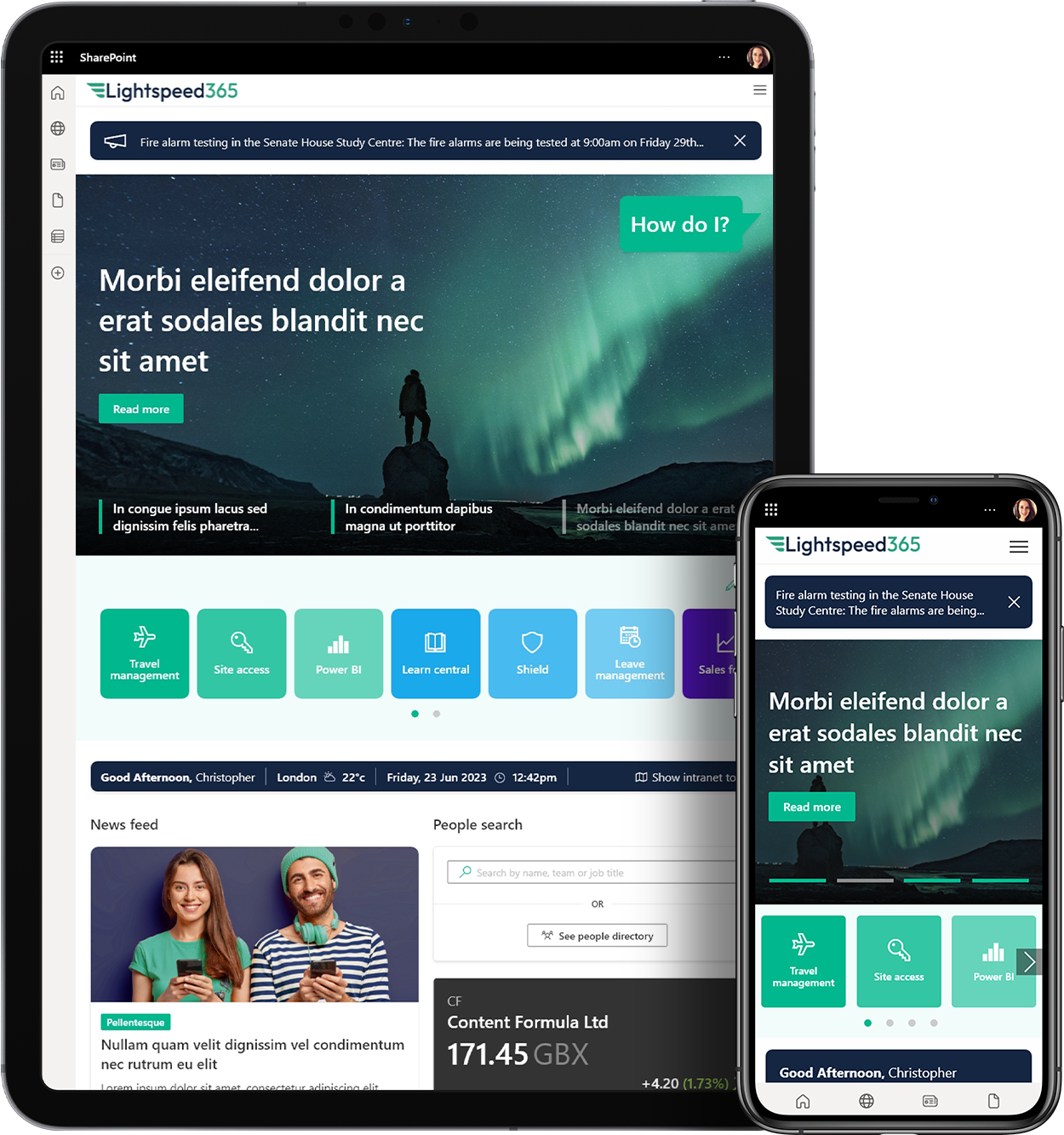 Launch of any new system or process can be a huge effort, as we discussed in our previous article about big bang intranet launches. Once youve launched SharePoint intranet, youre bound to see a lot of people trying to figure out how to make best use of its many features. These high levels of attention wont last.
Launch of any new system or process can be a huge effort, as we discussed in our previous article about big bang intranet launches. Once youve launched SharePoint intranet, youre bound to see a lot of people trying to figure out how to make best use of its many features. These high levels of attention wont last.
The curious but conservative will return to previous systems, like email, and the interested but untrained will find their every task and interaction with SharePoint to be frustrating.
SharePoint roll out isnt about the technology, or the new features; its about change, communications, engagement, and new ways of working. It is, succinctly, about people, and your organisations goals.
Lets take a look at some adoption tactics you can use to make your SharePoint roll-out a success.
Adoption tactics
Review these practical ideas and decide which match your needs.
User research
Nobody should design and build any kind of platform or service without diving into the user experience and doing copious user research.
But beyond the incredible value of such research, you can also treat every interaction with colleagues as an engagement activity. Every survey, every interview, every real-life or online exercise is an opportunity to explain the vision for and how SharePoint will meet peoples needs.
Someone who has been involved with research is likely to feel more enthusiastic about the intranet, and talk about the research with colleagues, helping to create further awareness.
Stakeholder mapping
There are different kinds of stakeholders not every stakeholder is a decision maker. That said, you should still understand the needs and expectations of stakeholders. This could be about creating accurate personas and / or developing use case narratives that show what your colleagues do in their work, and what they need from your collaboration platform.
Many developers and UX practitioners write their stakeholder mapping notes privately, because such notes may contain personal observations about specific individuals. Stakeholder mapping can include logging an individual stakeholders attitude regarding the vision and purpose of your SharePoint implementation, so that you can adapt your approach when asking them for support. These kinds of notes are the dirty secret of stakeholder management.
The sponsor show and tell sessions
Assuming you have a sponsor from the leadership team (perhaps the HR director, rather than the IT director or CIO) youll want to involve them in your pre and post-launch communications.
Rather than only relying on intranet articles and newsletters from them, consider running several show n tell sessions around your organisation, inviting stakeholders and end-users from different departments, and ensuring invitees know the sponsor will be present.
Authors, contributors, content and site owners
Even if your intranet governance is heavily centralised, you will still need competent site owners for the many collaboration Team Sites and even for Yammer Groups maybe.
If your governance model is collaborative or decentralised, then you may well have hundreds of authorised contributors. Be clear about who owns what on the intranet and provide support to owners and contributors by publsihing guides, tips, and examples of good practice. Explain roles and responsibilities, and provide regular training sessions through the year.
Community
Finding, engaging, and training authors and site owners should not be seen as an onerous process to get through as quickly as possible, but as an opportunity to build on-going relationships. Rather than automate the process (providing online guides etc.), have such contributors develop their skills and knowledge within a dedicated Team Site. Youre now a community manager, able to support peer-to-peer learning, and you can communicate progress and changes effectively. Use SharePoint and Yammer to engage your contributors; dont revert to email.
Share progress
Run a pre- and post-launch blog, to keep everyone involved and interested. Blog articles can show progress, share challenges, and explain how and why tough decisions were made. Your SharePoint project is not a secret its a business led improvement programme, and progress should be shared.
Your network of contributors should be kept in the loop and completely involved with your launch communications.
Workshops
Hold workshops across your organisation for contributors and champions. Ostensibly, its about classroom training, but in the early stages its about engagement and explaining the vision and purpose of the intranet, and presenting how features will work.
Training for site owners and content contributors
First theres the governance and administration of team sites, and all the buttons, processes, workflows, and configuration that SharePoint needs.
Then theres how best to use the functionality of SharePoint and how to write material that suits readers.
Many people will feel more confident once theyve had some real-life mentoring or training, even if you provide how to guides online. Content owners and contributors may well need training in order to become competent.
Manage the community
Have a central person for contributors to contact. If youre the sole intranet manager, this may well be you! As a community manager (supporting contributors) youll want to be available for any query. Help contributors rely on their dedicated Team Site or Yammer Group dont simply respond to emails, but take questions and answer them online, so that everyone benefits and can continue the discussion.
Offline comms
Naturally enough, a great deal of intranet news is communicated via the intranet. But to reach field workers, engineers, and customer service people, various channels are needed.
Consider print materials and desk drops explain key benefits, and how to contact the comms team / the intranet manager. Consider mouse mats and pens if appropriate to your org culture; some people see squeezy stress-relievers as gimmicky, others appreciate the token of a tiny box of chocs.
Identify resistance
Focus your initial engagement efforts on the people who are unsure of the benefits of new ways of working, but open to getting involved. Dont (yet) engage those who appear to be dead set against change or anything social or online. Embrace early adopters, but work closely with those who are ready for SharePoint but unsure where to start.
Once youve gained a critical mass of users, it will then be time to develop tactics to reach sceptics, ultra-conservatives, and general laggards.
On-going training
Dont only provide classroom and online training at launch; new people will join your organisation and your community of contributors. As new starters come in, arrange for the right level of SharePoint training as soon as their account has been set up. Consider putting links to intranet training and support materials in a prominent place weve come across some intranets where they opt to put it as a primary item on the main navbar.
Dont turn every feature on
Its tempting to launch with a big bang, showcasing every feature, every whistle, every bell. SharePoint is a big system; beyond the home page and department team sites, theres a lot going on. While youve spent six months planning and learning, many of your colleagues will feel overwhelmed by all the features of SharePoint 2013 or SharePoint Online.
Seeing as every feature should meet a business need, ensure the functionality you launch with matches your stakeholder expectations, and that end-users have been briefed and involved with the design of any new ways of working.
If a feature isnt absolutely needed at launch, consider only turning it on a few weeks later. This drip feed of functionality will demonstrate that youre continuously improving the intranet and in control of the roll out. Many organisations launch SharePoint with Yammer, but you can roll out and integrate Yammer later.
News
Whenever you enable a new feature, be sure to communicate its purpose and how people might use it. Over months, share tips and examples of how colleagues are using SharePoint features, highlighting the end result.
SharePoint isnt one single thing people experience it differently depending on their role and needs. Highlight the functionality and the many different use cases throughout the year, encourage questions, and dont be afraid to repeat messages over time.
Leader boards
Publish details and stats about the most read articles each month. Perhaps split the leader board up to show reference articles and blog articles separately. Departments should be interested in what material people are making use of, and individual bloggers will be pleased to see their work is appreciated. (Blogs are a great way to share expertise, and guidance for the many systems and processes your organisation uses).
Beyond leader boards, share relevant stats with your community of contributors.
What tactics have you used to support your adoption strategy?
Whether youre a proponent of Kotters approach to change, or a fan of the Kubler-Ross change curve, the Rogers technology adoption lifecycle, or Downes and Nunes shark fin model, youll want to have a pre, post, and on-going adoption strategy.
What tactics have you used to support adoption? What should be on this list? Please let us know in the comments section.
Photo credit: Montgomery County Planning



 SharePoint Products
SharePoint Products

